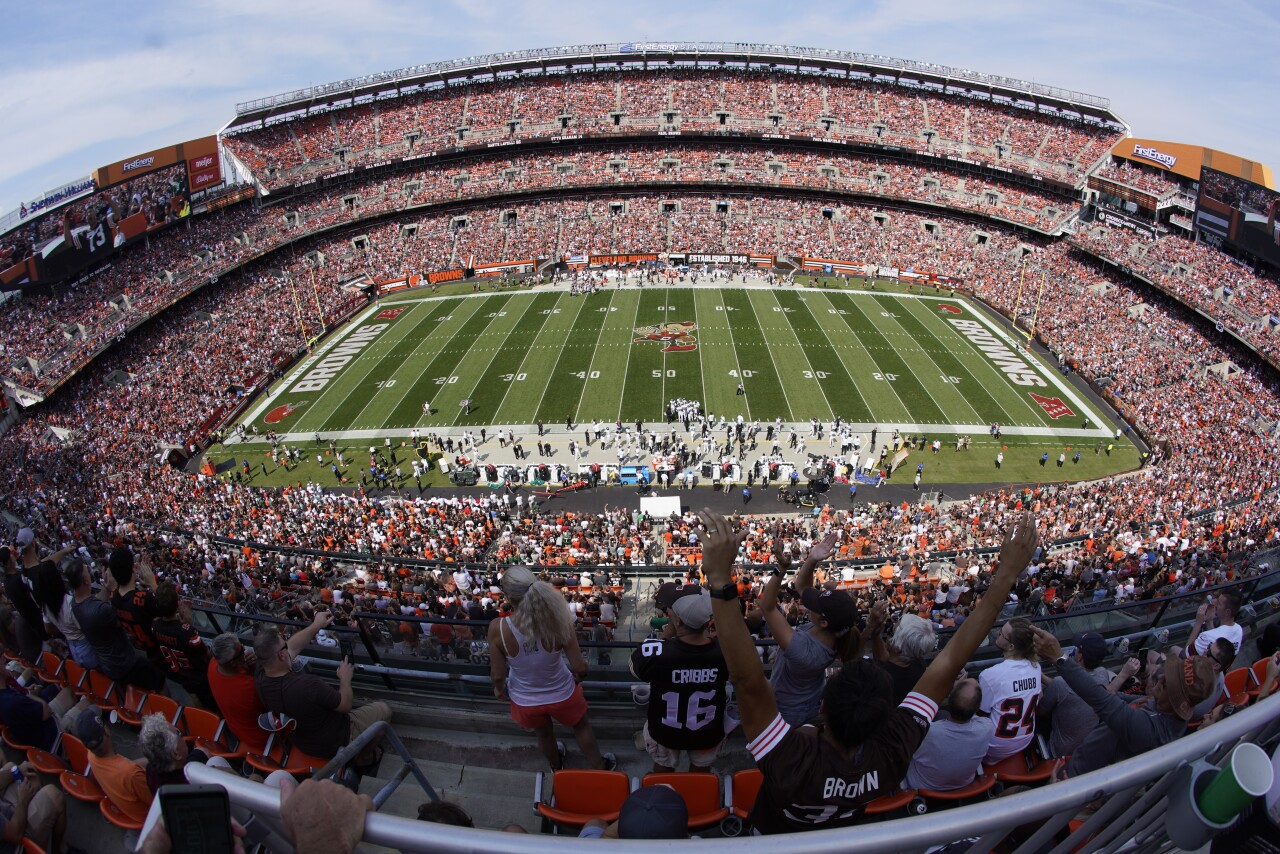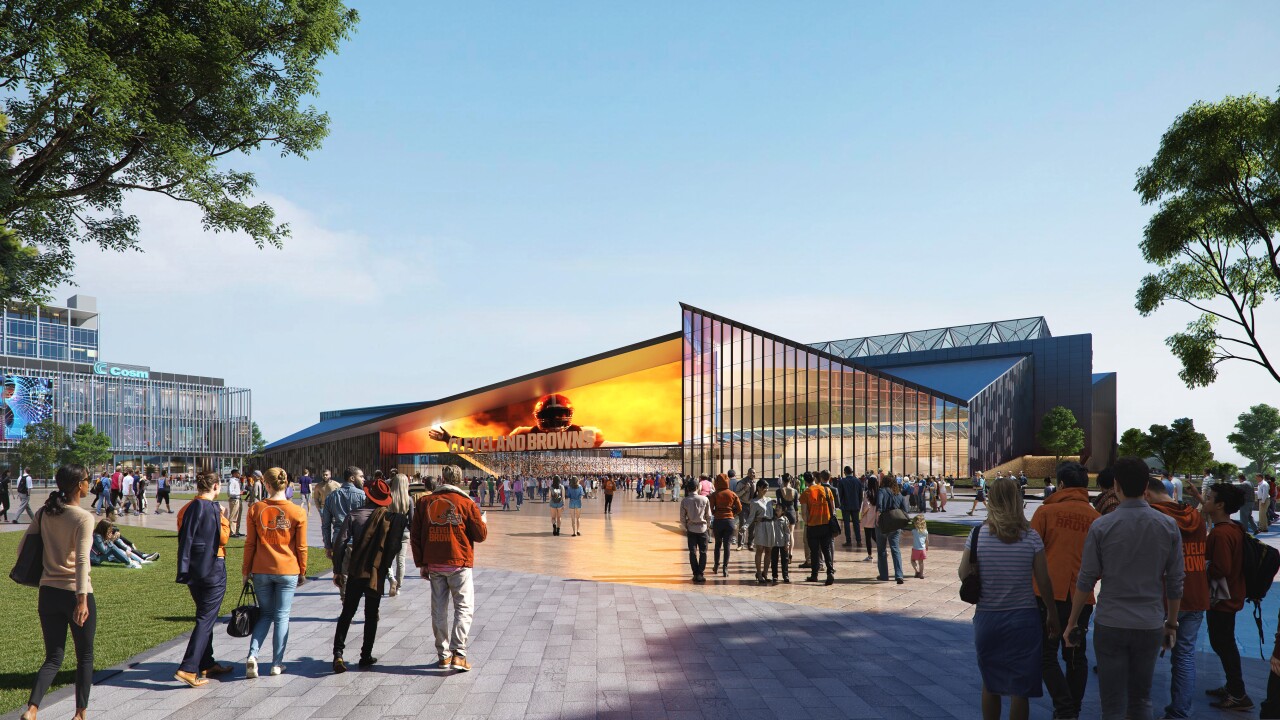CLEVELAND — As the Cleveland Browns and Haslam Sports Group focus on building a future in Brook Park, one big question keeps coming up: How will they pay for it?
We don’t have all the answers yet. But here’s a look at some of the most common questions we’re hearing, touching on everything from money to site control.
Q: What will the Brook Park project include?
The Browns released preliminary renderings of the project in August.
They show a domed stadium sunk about 80 feet into the ground, flanked by mixed-use development. That includes offices, a hotel, retail, apartments and about 14,000 parking spaces.
The property is a former automotive plant site, which Ford Motor Co. sold to a group of industrial real estate developers in 2021. At that time, Ford put deed restrictions on the land that limited its uses to industrial or commercial development.
But a document filed with the Cuyahoga County Fiscal Office shows that Ford recently lifted the use restrictions, after the developers took the property through an investigation and clean-up process with the Ohio Environmental Protection Agency.
Q: How will the Haslams pay for all of this?
The stadium is expected to cost $2.4 billion, a price tag that owners Jimmy and Dee Haslam are looking to split with taxpayers.
The surrounding development could cost more than $1 billion – and would be privately funded.

The Browns haven’t released details of their financing plan – in part because it’s still a work in progress.
But in a statement sent out Thursday, after Cleveland Mayor Justin Bibb broke the news about the end of negotiations Downtown, the Haslams said a new stadium “will not use existing taxpayer-funded streams that would divert resources from other more pressing needs.”
They’re talking, instead, about borrowing against future tax revenues created by the project. That could include admissions taxes, income taxes, parking taxes, hotel taxes and property taxes.
The idea is that a public-sector entity – or multiple governments or agencies – would issue bonds to help pay for construction. The debt service on those bonds would be paid using some of those new tax revenues.
Earlier this year, the Haslams were looking for a 50-50 split of the $1.2 billion public tab, with a $600 million ask to the state and $600 million from local governments.
The pitch was to have Cuyahoga County issue bonds covering the local share, with $300 million tied to tax revenues from Brook Park and $300 million tied to tax revenues from the county.
But in August, Cuyahoga County Executive Chris Ronayne said that was too much of a financial burden for the county to bear. He also expressed skepticism about the math.
“We believe, after analysis of the Cleveland Browns proposal for Brook Park, that this dog doesn’t hunt,” he said during a news conference when he urged the team to renovate in place Downtown.
We don’t know what the team’s financial projections look like – for the Browns, for Brook Park or for the region. In their statement, the Haslams described the project as a boon for Cleveland, Northeast Ohio and the entire state, between events, tourism and new jobs.
Brook Park Mayor Edward Orcutt told News 5 this week that he sees a big potential upside.
“I feel that we’ll be fine in the end, when we all sit down at the table and we’re able to work together on putting something in Brook Park that will help the entire region, when it comes to revenue,” he said.

Q: When will we know more?
That’s not clear, but the Browns are on a tight timeline.
Their lease on the existing stadium, which the city of Cleveland owns, ends after the 2028 season. They hope to move to Brook Park in 2029.
A new stadium could take three years to build – but there’s still a lot of work to do before construction starts.
Q: Do the Browns own the Brook Park property?
Not yet, according to public records. But they’ve laid the groundwork for a deal.
A notice of a purchase agreement filed with Cuyahoga County shows that Primacy Development LLC, a company tied to Haslam Sports Group, has until Dec. 31, 2025, to buy the 176-acre site. That document was signed in March by David Jenkins, the chief operating officer of Haslam Sports Group and the Browns.
The current owner of the property is a joint venture between three developers: Weston Inc. and the DiGeronimo Companies, both based in Northeast Ohio, and Scannell Properties, which is based in Indiana.
A Haslam Sports Group affiliate loaned more than $18 million to those developers in March, enabling them to pay off a bank loan, according to public records.

Q: What happens to the existing stadium?
That’s the city of Cleveland’s decision to make, if the Browns follow through on their plans.
The stadium is likely to be demolished, but it’s too early to say when that would happen or what will go on the land. The building sits on approximately 17 acres, according to public records.
The city’s new lakefront master plan calls for redeveloping the neighboring parking lots to the north while linking them to the center of Downtown with a land bridge over a reimagined Shoreway. Sketches show apartments, a hotel and a food hall, but 60% of the area will be public space, with a playground, a fishing pier, athletic courts and a beach.
Scott Skinner, executive director of the fledging nonprofit North Coast Waterfront Development Corporation, is responsible for working closely with the city to realize that lakefront vision.
“We expect to go back out to the public in the near future and start to talk about some other ideas,” he said of exploring ways to fill the stadium’s footprint.
At a public lakefront forum in August, when it was already clear the Browns were leaning toward Brook Park, attendees had the chance to suggest what they would put on that site.
“Folks had a lot of common big-picture ideas and thoughts, which were free public space areas where folks can go with their families and spend time down on the waterfront … in a green space where they do not have to pay for a ticket,” Skinner said. “Additionally, economic drivers. Downtown Cleveland is really important to the region.”
The city won $60 million in federal grants this week to kickstart a transformation of the Shoreway into a slimmer, slower boulevard – and has raised $80 million of the roughly $450 million it needs for all of the infrastructure work to link the lakefront to Downtown.
Skinner said losing the Browns doesn't impact that funding or the $20 million earmarked for the land bridge by state legislators. The city is seeking additional federal grants.




